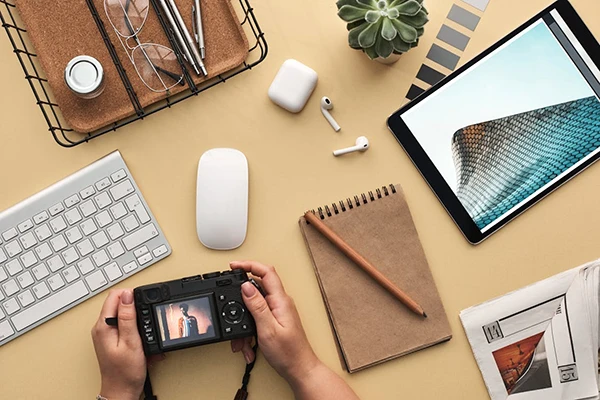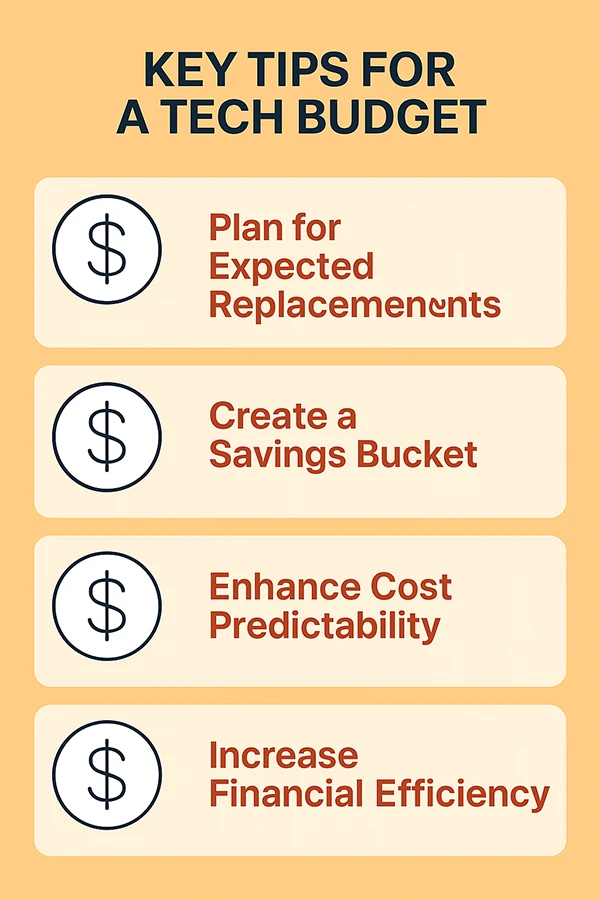KEY TAKEAWAYS
- Stay up to date with the latest technology and figure out what can help you.
- Tech is not about purchasing the latest gadgets; it’s more about understanding and utilizing them.
- Skills need investment as well.
- Always make a budget before buying any new tech, and keep in mind that over time, their price will only decrease.
It’s 2025, and now those things are possible that were once considered myth. But here we are living in this age where new technology is introduced nearly every other day. According to Forrester, the global tech spending has reached $1.50 trillion in 2024.
But are you keeping up with the latest technology? We have a busy schedule and barely get time for ourselves sometimes, so I get it can be hard. However, you can do a few things that keep you updated.
In this article, I’ll mention the practical side of staying current with technology. So, let’s get started.

Staying current doesn’t mean buying the latest release every time something new drops. It means knowing what tools still serve you, and which ones are slowing you down. You don’t need cutting-edge tech to be functional. You just need reliable tools that work well for how you actually live.
But when your gear really is outdated—sluggish load times, limited compatibility, or software that’s no longer supported—it makes sense to make a move. Not everything belongs in the junk drawer. Some items still have value, just not to you. If you’re trying to offset upgrade costs or free up space, one of the most practical strategies is to buy electronics for cash by exchanging what you no longer use through online or in-person services. This gives your older tech a second life and gives you a little more room in your budget for something new. No waste, no guilt, no landfill shame.
The key here isn’t just cleaning out your tech drawer. It’s being thoughtful about what’s worth replacing and what just needs a reset. Factory resets and software updates can extend the life of many devices without spending a cent. So always start with what you have. Declutter first, then decide what you actually need next.
One of the most common mistakes people make when trying to “stay updated” is treating each device as a standalone thing. A better mindset is to treat your tech life like a connected system.
For example, does your phone sync easily with your computer? Can you share files across devices without emailing yourself? Is your calendar updating everywhere? If not, you’re not behind in tech—you’re just operating in chaos. Choosing devices that work together smoothly saves time and limits frustration. You don’t need to go all-in on one brand, but consistency in operating systems or integrations can make life easier.
This systems-first mindset also helps you resist impulse buys. Instead of chasing whatever product is trending, you build around a clear ecosystem that supports your habits. When your tools function together, you use them better—and longer.
New gear is fun, but new knowledge is lasting. The person with the most updated devices isn’t always the most capable. It’s often the person who took 15 minutes to learn a shortcut, set up cloud storage properly, or watched a tutorial on managing settings.
This matters even more now, when so much tech is multifunctional. Phones are no longer just phones. Smartwatches track sleep, detect falls, ping your phone, and pay your bills. Your TV can host conference calls. But none of that matters if you don’t know how to use those features. Learning the full range of your devices means you can get more out of them before replacing them.
It also builds confidence. Tech isn’t just about keeping up—it’s about keeping control. When you know how your stuff works, you’re less likely to panic when something glitches. You troubleshoot first. You upgrade when it matters. You spend intentionally, not reactively.
Everyone thinks about upgrading hardware. Fewer people think about upgrading their routines. Efficiency doesn’t come from owning newer tools. It comes from using existing ones more smartly.
Start by asking where you waste the most time. Are you manually transferring files instead of automating it? Are you retyping emails instead of saving templates? Are you toggling between a dozen apps when one dashboard could do the job?
Streamlining your digital routines creates mental bandwidth. It also helps you spot gaps. You might realize you don’t need new tools—you just need better workflows.
It’s the difference between upgrading out of panic and upgrading with a plan. Panic-buying tech leads to clutter and wasted money. Planned upgrades, driven by actual use, stretch your budget and make your whole system smoother.
One reason tech upgrades feel overwhelming is because we treat them as surprise costs. But phones, computers, routers, even headphones—they wear out. It’s not a crisis. It’s normal.
Start budgeting for tech like you budget for car maintenance or utilities. Set aside a small amount monthly. That way, when you do need to replace something, you’re not wiping out your savings.
This mindset shift also takes the pressure off buying the shiniest thing. If you know you’ll upgrade again in a few years, you can choose what works best now—not what impresses people. Long-term thinking turns flashy decisions into sustainable habits. Below you can see some useful tips to budget for your tech.

The tech world rewards FOMO. New releases drop every few months, each one promising revolutionary changes. But not all improvements are necessary. Sometimes, a software update does more for you than a new device. Sometimes skipping a cycle means waiting for bugs to be worked out, or prices to drop.
Staying current doesn’t mean staying on the cutting edge. It means staying aligned with your needs. Not every app, platform, or wearable is worth your time. Choose what helps you live, work, or communicate more clearly. Ignore the rest.
The same goes for digital trends. You don’t have to join every new platform. You don’t need to track every AI release. Furthermore, you need to know what’s relevant to you, and learn enough to stay fluent in your corner of the digital world.
DID YOU KNOW?The International Space Station is considered to be the most expensive tech ever, valued at over $100 billion!
Ultimately, keeping up with tech shouldn’t feel like running behind. It should feel like staying in rhythm with your own priorities. That rhythm will change over time. Maybe you need better tools now to work remotely. Maybe later, you’ll focus on security, family tech needs, or accessibility.
As long as your choices are rooted in how you live, not how you compare, you’ll be ahead in the ways that matter. Stay curious. Ask questions. Learn the features. Skip the hype. Trade in what no longer fits. Use what you have more wisely. That’s the real upgrade.
There are several things that you can do to keep updated, reading tech-based articles/papers, attending conferences, watching TED talks or podcasts circling around new technology, etc.
If you are keeping up with technological trends, you gain a competitive edge, can access new features, and save your precious time/money.
Make sure to have some offline time when you go out and enjoy yourself. Do activities like cycling, hiking, playing with kids etc., as it refreshes your mind.
